Drop in milk production, acute respiratory signs and deaths associated with heat stress in dairy cattle in Uruguay
Keywords:
Climate, Dairy farming, Holstein cattle, Production diseases, Respiratory signsAbstract
On March 2017, a clinical episode of heat stress in Holstein cows was diagnosed in a dairy farm from southwest Uruguay. After the consumption of the morning feed, 6 of 189 cows presented dyspnea, orthopnea, and open-mouth breathing. One cow died during the manifestation of these clinical signs, the other five cows recovered a few minutes afterwards. Another cow died the night before. There were no lesions in the respiratory system. The maximum Temperature Humidity Index (THI) recorded on February 27-28 and March 1 was 83.5, 83.5 and 83.0, respectively, indicating a heat wave and moderate heat stress. No ergoalkaloids were detected upon toxicological evaluation of the feed. The sudden onset of clinical signs, the lack of lesions in the respiratory tracts, and the moderately elevated THI registered for a prolonged period, indicated an acute clinical episode of heat stress with fatal outcome. The retrospective analysis of the daily THI and average milk production revealed that the clinical episode was preceded by a marked subclinical reduction of milk production from February 15 to March 2, associated with a high THI registered in that period. This was followed by a partial recovery of milk production between March 3 and March 15, in association with a concomitant reduction of the THI and, therefore, of heat stress. This report highlights the need for applying adequate mitigation strategies to prevent and control heat stress during summer in dairy cows in Uruguay.











